Birds in Lincoln, Nebraska, are a diverse avian species, ranging from small songbirds to large waterfowl. These birds can be found in backyards, parks, and open spaces throughout the city.
Various species can be seen in Lincoln, from the American Goldfinch to the Great Blue Heron. Birdwatchers and nature enthusiasts will enjoy exploring the many habitats throughout the city and learning about the unique species that call Lincoln home.
22 Birds to Watch in Lincoln
If you are a bird lover and live in or near Lincoln, you are in luck. There are many places where you can enjoy bird watching and see a variety of species, from common garden birds to rare migrants.
Here are 22 birds that you should look out for in Lincoln and where to find them.
1. Lincoln’s Sparrow
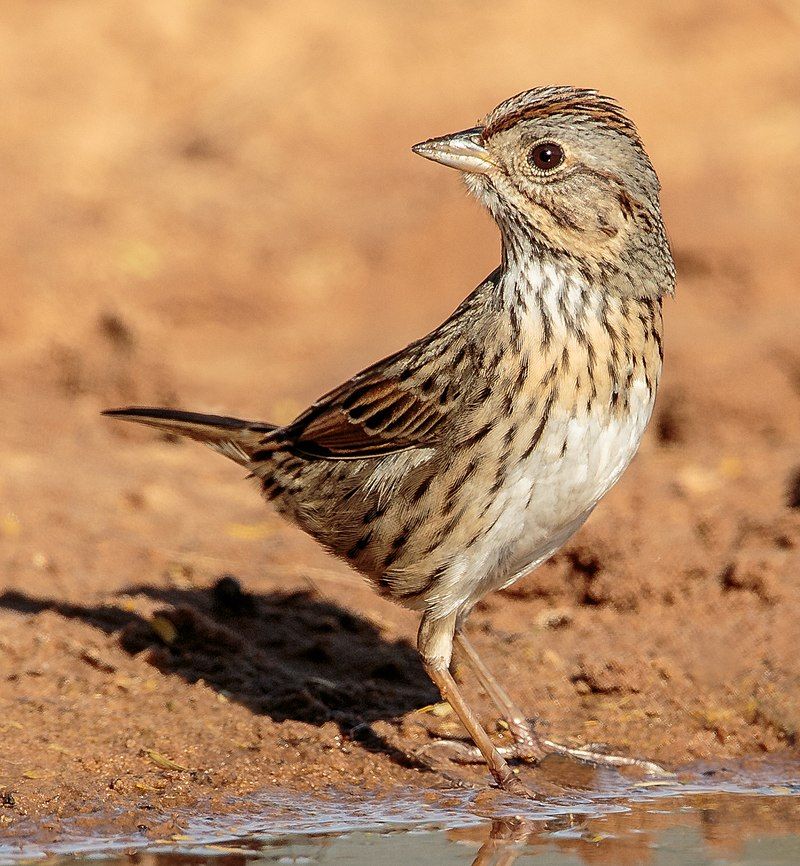
The Lincoln’s sparrow is a diminutive bird native to North America. It is a member of the passerine family, which includes songbirds, but is less common than many of its relatives. This tiny bird prefers to stay hidden in thick ground cover, making it hard to spot.
However, it can be identified by its distinctive, melodious song, which resembles a wren’s. The Lincoln’s sparrow is a small, gray-brown bird with a white belly and a buff-colored breast. It has a short, conical bill and a black eye stripe that stretches across the face.
Its wings are short and rounded, and the tail is long and pointed. Its plumage helps it to blend in with its environment, making it well-equipped for life in the undergrowth. The Lincoln’s sparrow is a ground-dweller, rarely seen in the open.
It prefers to forage on the ground for insects, seeds, and berries. It is most active in the mornings and evenings when it sings its sweet, wren-like song. It is a shy bird, often fleeing at the sound of humans, but its song is a sure sign that it is nearby.
The Lincoln’s sparrow is a unique and fascinating bird often overlooked in favor of more showy species. Despite its small size and shyness, this bird has a striking beauty best appreciated from a distance.
Its melodious song is a reminder of the hidden wonders of nature that can be found with just a little effort.
| Kingdom | Animalia |
| Phylum | Chordata |
| Class | Aves |
| Order | Passeriformes |
| Family | Passerellidae |
| Genus | Melospiza |
| Species | M. lincolnii |
2. Dark-Eyed Junco
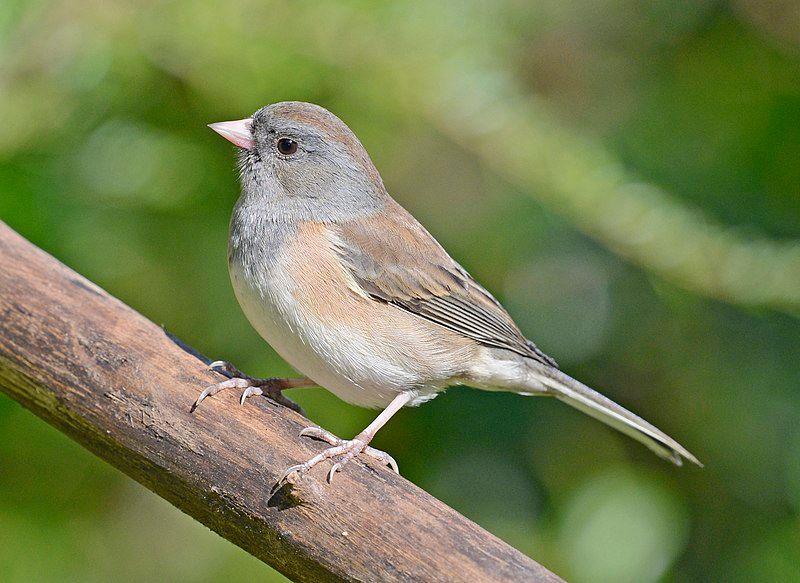
The dark-eyed junco is a small, grayish bird belonging to the junco species, part of the New World sparrows. It is prevalent across temperate North America and can even travel to the Arctic during summer.
It has a lot of variations, much like the fox sparrow, and scientists have yet to understand its full systematics. This species is quite common and familiar to many, but its behavior and systematics are still somewhat of a mystery.
The dark-eyed junco is a small bird, usually 6 to 7 inches long, with a grayish body and a white belly. Its wings are gray with white markings, and it has a long and dark tail. Its eyes are a dark, almost black, color, which makes it easy to identify.
It is a reasonably common sight, usually found in woodlands and forests, but can also be seen in gardens and other open areas. It feeds on seeds, berries, and insects and is known to be quite shy and easily startled.
The dark-eyed junco is related to the fox sparrow, another small, grayish New World sparrow species. The two species have a lot of similarities, although the dark-eyed junco is the more common one.
There are many differences between the two species, but the most important one is that the dark-eyed junco is much more variable. This means it can have different colors and patterns, making distinguishing between the two species difficult.
Scientists still have yet to understand the systematics of the dark-eyed junco fully. Despite its wide range and familiarity with many people, it remains a mystery.
Scientists are still working on untangling the systematics of the species, which will help them to understand its biology and behavior better. Overall, the dark-eyed junco is a common and familiar species of New World sparrows.
Its systematics are still not completely understood, making it a mystery. However, its wide range and varied colors and patterns make it a fascinating bird to observe and appreciate.
| Kingdom | Animalia |
| Phylum | Chordata |
| Class | Aves |
| Order | Passeriformes |
| Family | Passerellidae |
| Genus | Junco |
| Species | J. hyemalis |
3. Cooper’s Hawk
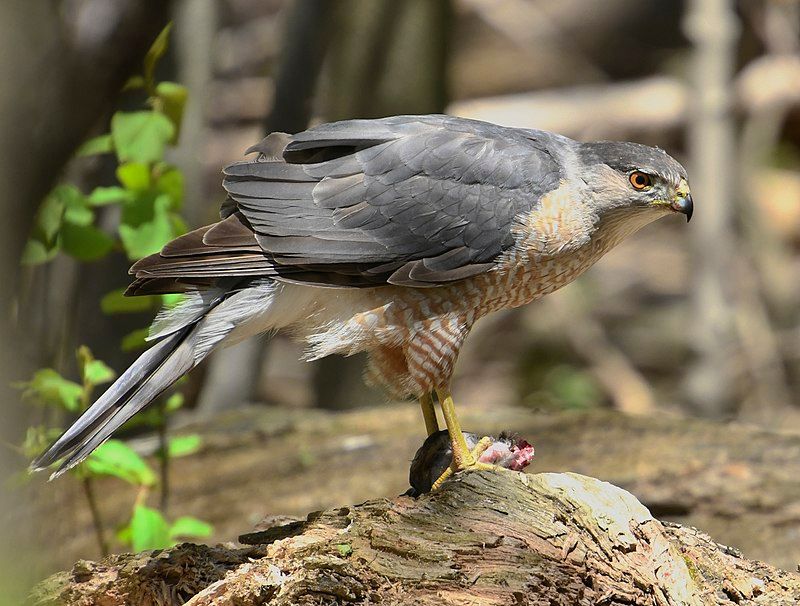
Cooper’s hawk is a raptor that is found throughout the North American continent. It is a medium-sized hawk with a length of about 16-24 inches and a wingspan of around 28-35 inches. A dark gray-brown upper body, a white chest, and a barred tail characterize it.
This species of hawk is native to the continent, and its range extends from southern Canada to Mexico. The Cooper’s hawk is a forest bird, and it can be found in both deciduous and coniferous forests.
It mainly feeds on small birds, such as doves and finches, but they also feed on small mammals, such as squirrels, rabbits, and mice.
This species of hawk is known for its agility and speed while hunting and is an effective hunter of small birds. The Cooper’s hawk is a solitary species, building its nest in the trees. It lays 2-4 eggs in its nest, which hatch after 31-35 days.
The young hawks become independent after 6-8 weeks and start hunting for themselves. Cooper’s hawk is a species that has adapted well to human presence and can often be seen in urban areas.
It is a species of most minor concern, and its population is considered stable.
| Kingdom | Animalia |
| Phylum | Chordata |
| Class | Aves |
| Order | Accipitriformes |
| Family | Accipitridae |
| Genus | Accipiter |
| Species | A. cooperii |
4. American Goldfinch
The American goldfinch is a small bird that belongs to the finch family and is native to North America. It is a migratory species, moving between different regions during different times of the year.
During the breeding season, the American goldfinch can be found in an area stretching from mid-Alberta to North Carolina, while it moves further south during the winter, going as far as just south of the Canada-United States border and even into Mexico.
Its broad geographical range is an impressive feat for such a small bird.
| Kingdom | Animalia |
| Phylum | Chordata |
| Class | Aves |
| Order | Passeriformes |
| Family | Fringillidae |
| Genus | Spinus |
| Species | S. tristis |
5. Brown creeper
The brown creeper is a small songbird native to North America. It is the only member of its family, Certhiidae, in North America. It is also known as the American treecreeper. This species is a small, brown bird with a white belly and a long, thin bill.
It has a slender body and a long tail. The brown creeper can be found in forests all across its range, where it feeds on insects and spiders by clinging to the trunks and branches of trees. It searches for food with its bill, probing underneath the bark and into crevices.
The bird often spirals up the tree trunk or branches in search of food; its tail cocked up in the air. It is an integral part of the forest ecosystem, helping to keep insect populations in check.
The brown creeper is a migratory species seen in winter in Mexico and the southeastern United States.
| Kingdom | Animalia |
| Phylum | Chordata |
| Class | Aves |
| Order | Passeriformes |
| Family | Certhiidae |
| Genus | Certhia |
| Species | C. Americana |
6. Sharp-Shinned Hawk
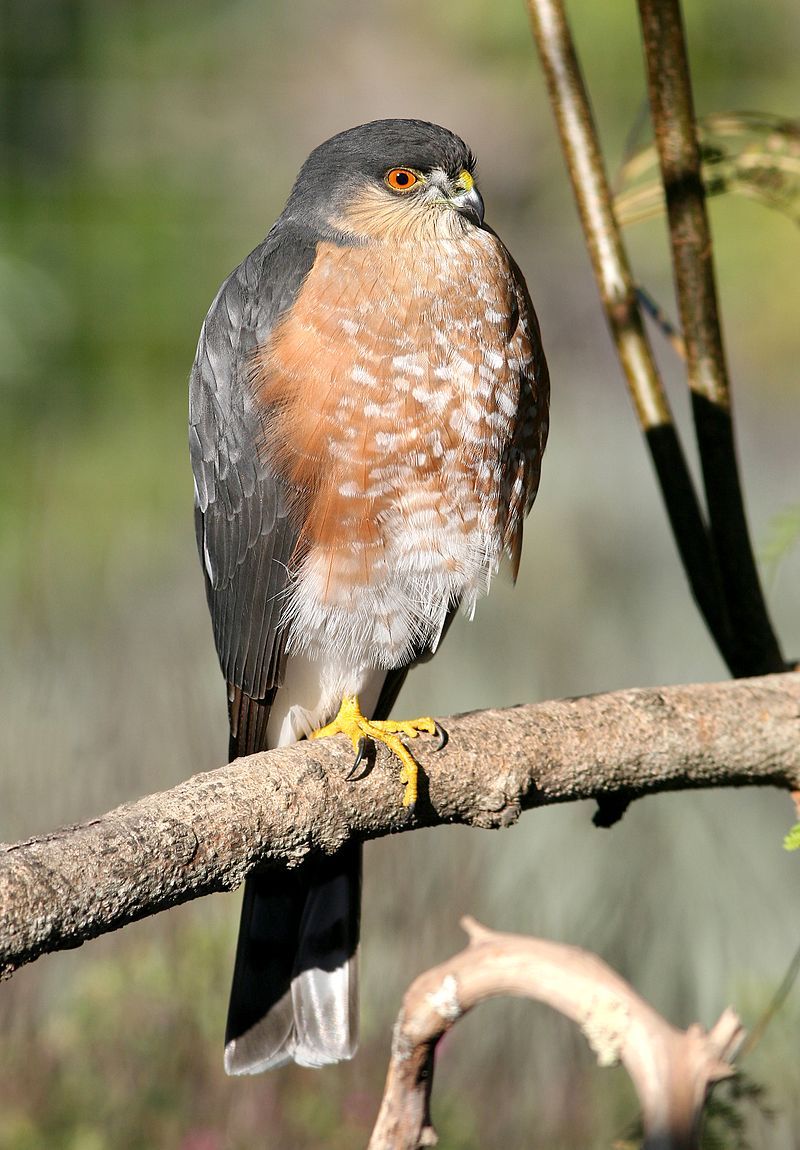
The sharp-shinned hawk, or Northern sharp-shinned hawk, is a small hawk found in the United States and Canada. It is commonly called a “sharpie” and is generally the most minor hawk type in the two countries.
Despite this, the average size of the sharp-shinned hawk is more significant than some of the Neotropical species, such as the tiny hawk. This is because male Sharpies are the smallest hawks in the two countries.
The sharp-shinned hawk is a unique species with a long and recognizable tail, a small head, and a slim body. Its wings and tail are usually grayish-brown, while its breast and belly are pale white, giving it a distinct look.
Its primary food source is small birds, which it captures in mid-air. It is an agile and swift hunter capable of reaching up to 40 miles per hour in pursuit of its prey.
| Kingdom | Animalia |
| Phylum | Chordata |
| Class | Aves |
| Order | Accipitriformes |
| Family | Accipitridae |
| Genus | Accipiter |
| Species | A. striatus |
7. Song Sparrow
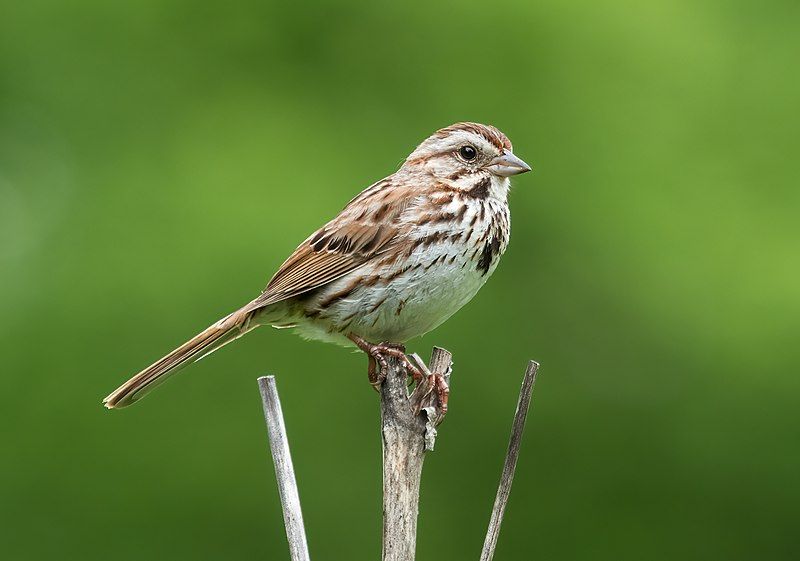
The song sparrow is a small yet powerful bird native to North America. It has many habitats, from dry grasslands to thick forests. This sparrow is a medium-sized bird, typically measuring 5-6 inches long.
It has a short, stout bill, a brown back with streaks of black and white, and a grayish-white belly.
Sparrow is also easily recognizable by its song, melodic chirping that it sings to attract mates and mark its territory. The song sparrow is an incredibly abundant species, with an estimated population of over 700 million across the continent.
It is also considered one of the most variable and adaptable species of native sparrows. This is due to its ability to adjust to different habitats and feed on various food items, from insects and seeds to fruits and berries.
The song sparrow also has the advantage of being able to nest in both trees and shrubs and on the ground.
This allows it to take advantage of different food sources and nesting spots. Overall, the song sparrow is an incredibly abundant and adaptable species of sparrows native to North America.
It can thrive in a wide variety of habitats and feed on a variety of food items. This makes it one of the continent’s most abundant and adaptable species of sparrows.
| Kingdom | Animalia |
| Phylum | Chordata |
| Class | Aves |
| Order | Passeriformes |
| Family | Passerellidae |
| Genus | Melospiza |
| Species | M. melodia |
8. Northern Cardinal
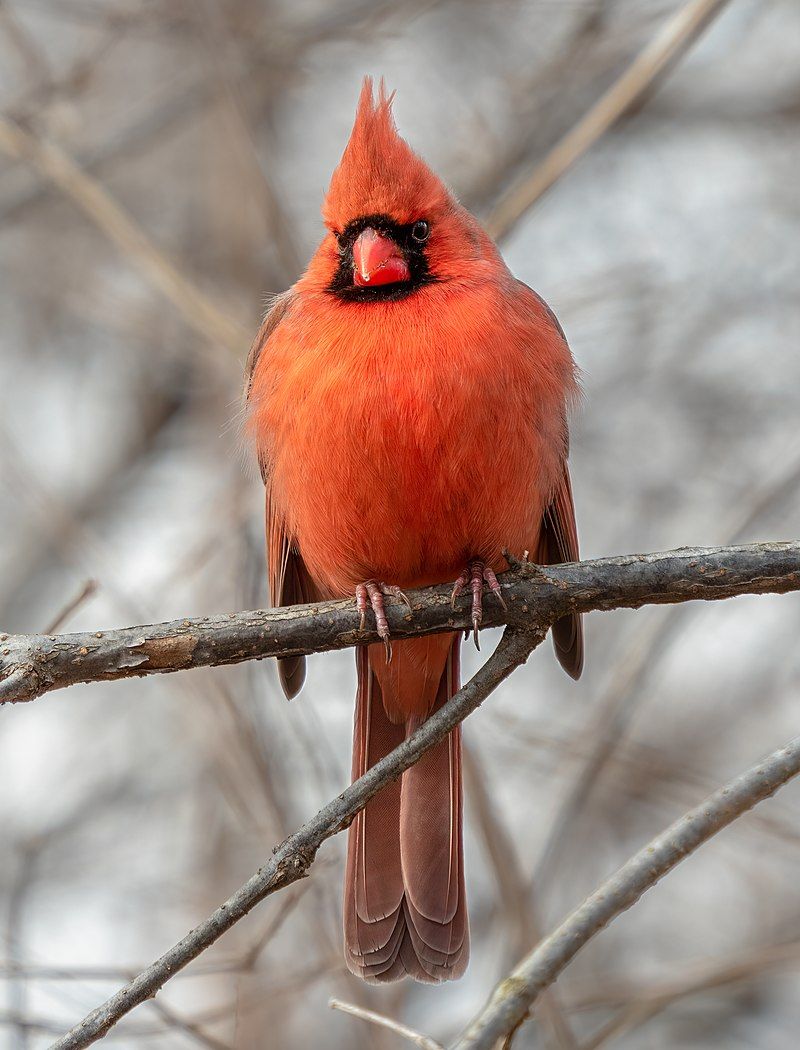
The northern cardinal is a species of bird in the genus Cardinalis, and it is commonly referred to as the redbird, common cardinal, red cardinal, or simply cardinal.
It is famous for its bright red coat and black mask, distinct features that distinguish it from other species. The male northern cardinal is the most easily identifiable, with its bright red feathers and black mask.
The female is more subdued in color, with a gray-brown body and a red tinge on the wings, tail, and crest. The cardinal is found across the eastern and central United States and parts of Mexico and Canada.
It is a famous backyard bird, and individuals are often seen perched in trees or on feeders. The northern cardinal is a vocal species with various songs and calls.
It prefers open woodlands, forest edges, and thickets, usually near water sources, and it feeds mainly on seeds and insects.
| Kingdom | Animalia |
| Phylum | Chordata |
| Class | Aves |
| Order | Passeriformes |
| Family | Cardinalidae |
| Genus | Cardinalis |
| Species | C. cardinalis |
9. Blue-Gray Gnatcatcher
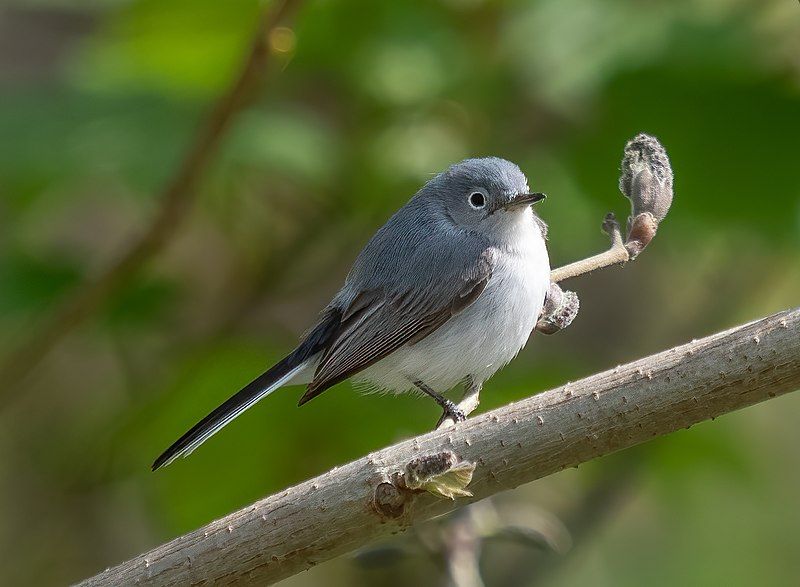
The blue-gray gnatcatcher, also known as the blue-grey gnatcatcher, is a tiny songbird native to North America. It is a bright blue-gray, typically 3 and 5 inches long, with a wingspan of 6 to 8 inches.
This species can often be seen foraging in dense foliage or among the branches of trees and shrubs. Its diet consists mainly of insects, especially gnats, flies, and beetles. In addition to these, it also feeds on spiders, caterpillars, and the occasional berry.
The blue-gray gnatcatcher is a migratory species, traveling between its breeding grounds in the east and south of the United States and its wintering grounds in the Caribbean and Central America.
Its song is a high-pitched buzzy trill, similar to that of the warbler family, and its call is a sharp “chick.” This species is a keystone in its habitat, as it helps control insect populations and disperse seeds.
It is a widespread species among birders, as it is relatively easy to observe and photograph.
| Kingdom | Animalia |
| Phylum | Chordata |
| Class | Aves |
| Order | Passeriformes |
| Family | Polioptilidae |
| Genus | Polioptila |
| Species | P. caerulea |
10. White-Crowned Sparrow
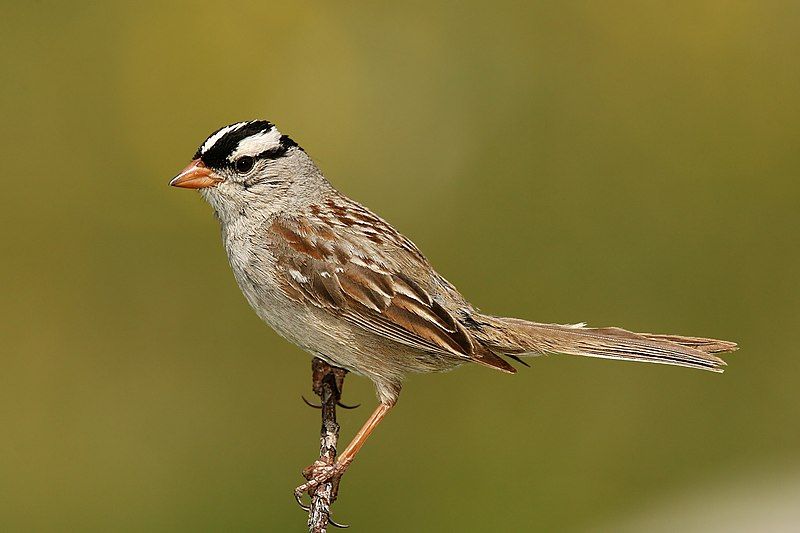
The white-crowned sparrow is a type of bird native to North America. It is a member of the New World sparrow family and is considered to be of medium size. Its distinguishing features are a grey face and white streakinstreaksupper head.
This type of sparrow is often seen in open areas such as fields, parks, yards, woodlands, and forests. It is a very social species, usually gathering in large flocks and associating with other types of birds.
The white-crowned sparrow feeds on various items, such as insects, seeds, and berries. These birds also migrate during the colder months, traveling south to warmer climates. In the summertime, they are found in northern North America.
The white-crowned sparrow is an integral part of the ecosystem in North America, and their presence is essential to maintaining the balance of nature in the region.
| Kingdom | Animalia |
| Phylum | Chordata |
| Class | Aves |
| Order | Passeriformes |
| Family | Passerellidae |
| Genus | Zonotrichia |
| Species | Z. leucophrys |
11. House Finch
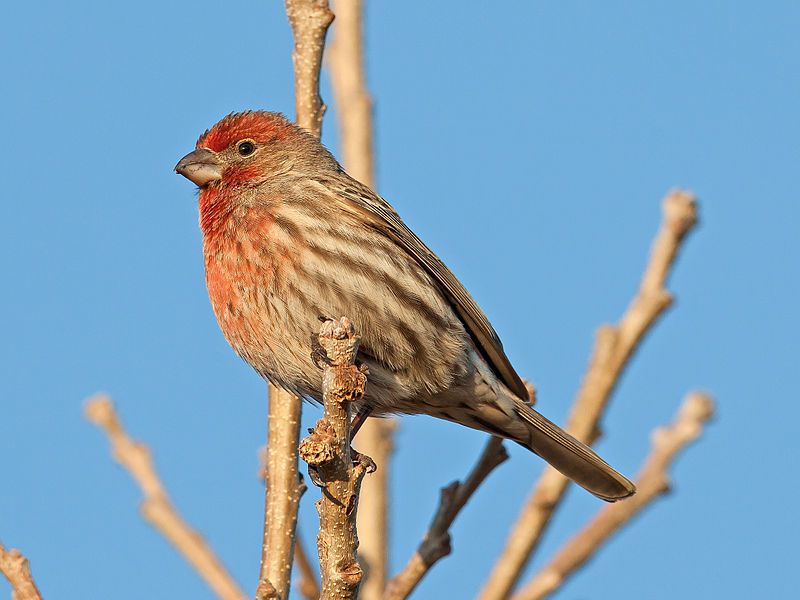
The house finch is a species native to western North America and introduced to the eastern half of the continent and Hawaii. It belongs to the family Fringillidae, which includes many other species of finches.
This species, along with two other species of American rosefinches, are all placed in the genus Haemorhous. This genus includes many finch species, all small, seed-eating birds with conical bills and colorful plumage.
The house finch is a medium-sized finch with an average length of about five inches and a wingspan of up to eight inches. Its plumage is primarily red, with some brownish tones, and its undersides are typically pale.
It feeds mainly on seeds but will eat insects, fruits, and nectar when available. The house finch is a common sight in gardens, parks, and other open areas and is a popular choice for birdwatching.
| Kingdom | Animalia |
| Phylum | Chordata |
| Class | Aves |
| Order | Passeriformes |
| Family | Fringillidae |
| Genus | Haemorhous |
| Species | H. mexicanus |
12. Common Grackle
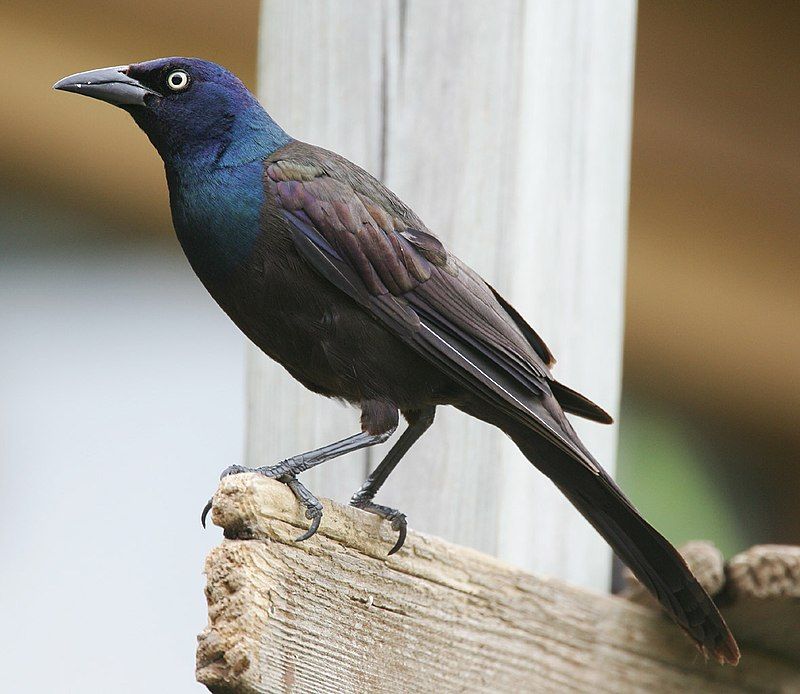
The common grackle is a species of bird belonging to the icterid family. It is found in large numbers throughout much of North America, first described by Carl Linnaeus in 1758.
This species is divided into three subspecies, with the adult common grackle having a long and dark bill, pale yellow eyes, and a long tail. The common grackle is a medium-sized bird, usually measuring around 8 to 12 inches in length and weighing between 1.2 and 2 ounces.
It has a dark, iridescent coloration, with its wings and tail slightly lighter black shade. The common grackle’s head, neck, and chest are a bright purple or blue, while the underparts are a lighter shade of gray.
The common grackle is a vocal bird with a contact call and a courtship song. Its contact call is a harsh, metallic “tchik” sound, while its courtship song is a series of short notes, usually lasting for about one second.
Its diet consists mainly of insects, seeds, and berries, though it is also known to consume small reptiles and amphibians. The common grackle is a reasonably social bird, often found in large flocks.
It also forms mixed-species flocks, often with other icterids such as cowbirds, blackbirds, and orioles. These flocks can become quite prominent in the fall and winter, sometimes numbering in the thousands.
The common grackle is an important species to many North American ecosystems. It serves as an important seed disperser and insect predator, helping keep the ecosystem balanced.
It is also an important species for birdwatchers, who enjoy observing its colorful plumage and vocalizations.
| Kingdom | Animalia |
| Phylum | Chordata |
| Class | Aves |
| Order | Passeriformes |
| Family | Icteridae |
| Genus | Quiscalus |
| Species | Q. quiscula |
13. Belted Kingfisher
The Belted Kingfisher is a large bird that is native to North America and is easily recognizable due to its size and bright blue and white coloration. This species is a member of the bird family Alcedinidae, which includes all kingfishers.
Recent research has revealed that this family should be divided into three distinct subfamilies. These are the Alcedininae, Daceloninae, and Cerylinae.
The Belted Kingfisher belongs to the Alcedininae subfamily, including all the kingfishers found in North and South America. This subfamily includes other species, such as the Green Kingfisher, Ringed Kingfisher, and Amazon Kingfisher.
The Daceloninae and Cerylinae subfamilies comprise kingfishers in Africa, Asia, and Oceania. This research has helped me understand better the diversity and evolution of kingfishers and how they are related to one another.
| Kingdom | Animalia |
| Phylum | Chordata |
| Class | Aves |
| Order | Coraciiformes |
| Family | Alcedinidae |
| Genus | Megaceryle |
| Species | M. alcyon |
14. Short-Eared Owl
The short-eared owl is a species of owl belonging to the family Strigidae. Found in grasslands worldwide, these owls belong to the genus Asio, sometimes referred to as the eared owls.
This nickname is due to the tufts of feathers on the heads of these owls, which resemble mammalian ears. Whether or not these tufts of feathers are visible depends on the individual owl.
Some may have visible tufts, while others may not have any feathers that resemble ears. Despite this, they are still known as eared owls.
| Kingdom | Animalia |
| Phylum | Chordata |
| Class | Aves |
| Order | Strigiformes |
| Family | Strigidae |
| Genus | Asio |
| Species | A. flammeus |
15. Red Kite
The red kite is a bird of prey belonging to the family Accipitridae. This family includes many diurnal raptors like eagles, buzzards, and harriers. Red kites are medium-large birds, and they are found only in Europe today.
However, in the past, they also bred in the regions of West Asia and Northwest Africa. Red kites are highly recognizable due to their reddish-brown plumage, often seen soaring gracefully in the sky for food.
They mainly feed on small mammals and carrion but are also known to eat some insects and even scavenge scraps from human settlements.
The red kite is an important indicator species for the health of its environment, and its presence can indicate a healthy, balanced ecosystem.
| Kingdom | Animalia |
| Phylum | Chordata |
| Class | Aves |
| Order | Accipitriformes |
| Family | Accipitridae |
| Genus | Milvus |
| Species | M. milvus |
16. White Wagtail
The white wagtail is a small bird that belongs to the family Motacillidae, this family also includes other birds such as pipits and longclaws. This bird species is known to breed in many parts of Europe, the Asian Palearctic, and some parts of North Africa.
It also has a toehold in Alaska, where it is known to breed, although uncommon. The white wagtail has a distinctive appearance, with its black and white plumage and long tail. Its long tail is often seen flicking up and down as the bird hops along the ground.
Its diet consists of insects and other small invertebrates, which it catches by hovering or chasing after them. It is also known to eat small amounts of grains and fruits. The white wagtail is a very social bird, often seen in large flocks when migrating.
It is also known to nest near water, often near streams and rivers. Its nest is a cup-shaped structure made of grass and feathers, which can be found in low shrubs or trees.
The white wagtail is an essential bird species recognized by many countries as a species of conservation concern. It is protected in some parts of Europe, Asia, and Africa, and efforts are being made to conserve its habitats and populations.
| Kingdom | Animalia |
| Phylum | Chordata |
| Class | Aves |
| Order | Passeriformes |
| Family | Motacillidae |
| Genus | Motacilla |
| Species | M. alba |
17. Great Blue Heron
The great blue heron is a majestic wading bird part of the Ardeidae family of herons.
It is commonly found near the shores of open water and in wetlands across most of North and Central America, as well as in some parts of northwestern South America, the Caribbean, and the Galápagos Islands.
This bird has a long neck and a sharp beak that helps it hunt for fish, frogs, and other small prey. It also has a distinct blue-gray coloration, named the “great blue heron.”
It typically stands still for a few moments before slowly lifting its wings and flying away. This bird is essential to many ecosystems and provides a valuable animal food source.
| Kingdom | Animalia |
| Phylum | Chordata |
| Class | Aves |
| Order | Pelecaniformes |
| Family | Ardeidae |
| Genus | Ardea |
| Species | A. herodias |
18. Wilson’s Warbler
Wilson’s warbler is a small passerine bird native to the New World. It has a distinctive plumage, with its back being predominantly greenish and its underside yellow. Its wings are rounded, and its tail is long and slim.
The male of the species has a black patch on its crown, which is either reduced or absent in the female, depending on the subspecies. This species is found in various habitats, including open woodlands, shrublands, and gardens.
It feeds on various insects and fruits and can often be seen flitting around in search of prey. It makes a distinctive call, described as a “buzzy trill,” frequently heard while the bird is foraging.
| Kingdom | Animalia |
| Phylum | Chordata |
| Class | Aves |
| Order | Passeriformes |
| Family | Parulidae |
| Genus | Cardellina |
| Species | C. Pusilla |
19. Kentucky Warbler
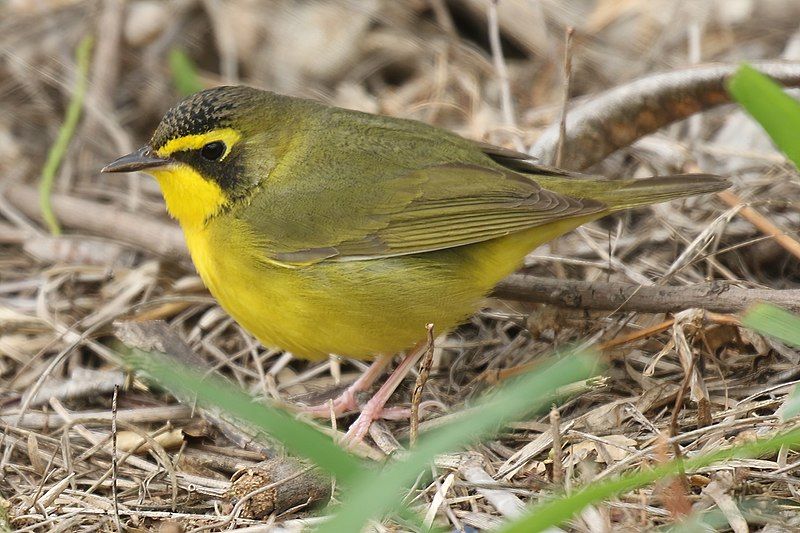
The Kentucky warbler is a unique species found in the New World. Its slow-moving behavior and short tail characterize it compared to other singers.
This species is inactive and spends most of its time foraging on the ground or low vegetation instead of in the air or on high branches like other singers.
The Kentucky warbler is known for its straightforward, melodic song, often sung from high branches or other elevated perches. This species has a brownish-olive back, a yellow throat, breast, and belly, and a white eye ring.
It is found in North and Central America, from the southeastern United States to Costa Rica.
| Kingdom | Animalia |
| Phylum | Chordata |
| Class | Aves |
| Order | Passeriformes |
| Family | Parulidae |
| Genus | Geothlypis |
| Species | G. formosa |
20. Red-Headed Woodpecker
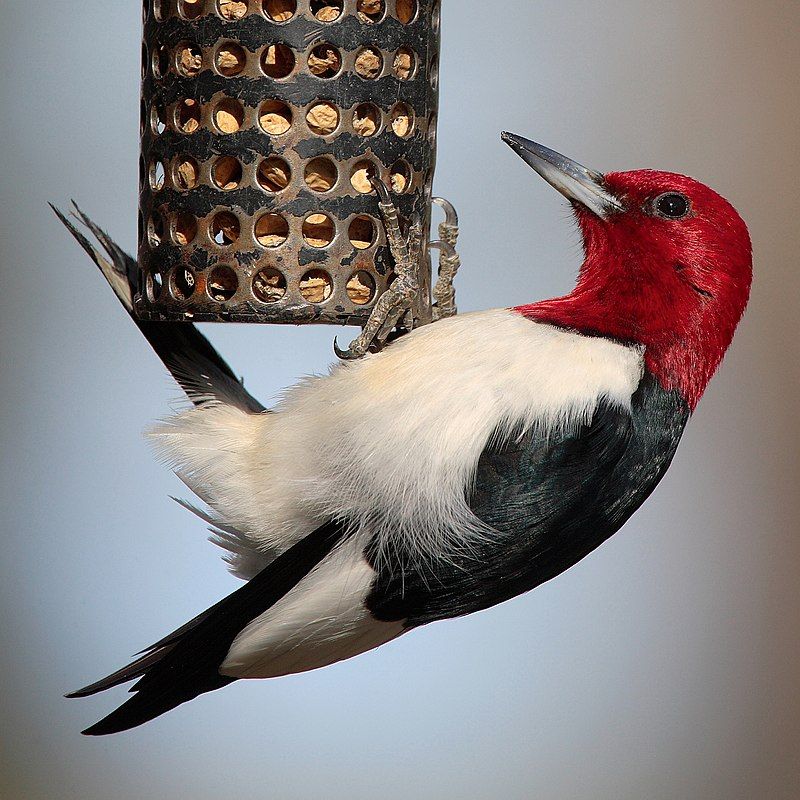
The red-headed woodpecker is a distinctive bird in much of temperate North America. It is a mid-sized woodpecker with a bright red head and neck, black and white wings, and a white underside.
Its breeding habitat is widely dispersed across southern Canada and the east-central United States, where it favors open country with trees for nesting. The red-headed woodpecker is known for its loud call, making it a familiar sight and sound in its range.
The birds are also commonly seen on fence posts, trees, and utility poles, feeding on insects, seeds, and fruits. They also feed on carrion, making them helpful to farmers and gardeners.
Red-headed woodpeckers use artificial structures, such as birdhouses, to nest. They are also known to cache food for later use.
In recent years, their population has declined due to the destruction of their habitats, but they are still considered a common species in much of their range.
| Kingdom | Animalia |
| Phylum | Chordata |
| Class | Aves |
| Order | Piciformes |
| Family | Picidae |
| Genus | Melanerpes |
| Species | M. erythrocephalus |
21. Bewick’s Wren
The Bewick’s wren is a species of wren native to North America. This wren species is the only one placed within the genus Thryomanes. The Bewick’s wren is roughly 14 cm long, with a grey-brown coloration above and white below.
It also features a distinctive long white eyebrow, distinguishing it from the Carolina wren. The Bewick’s wren also has a long tail tipped in white. This feature further helps to differentiate it from the Carolina wren.
The Bewick’s wren is friendly, often seen in pairs or small flocks. It is an active forager and is known to visit bird feeders. Its diet consists mainly of insects and seeds, with the occasional fruit.
The Bewick’s wren inhabits various habitats, such as woodlands, grasslands, scrub, and even urban areas. The Bewick’s wren is a common species throughout its range. It is not considered at risk and is abundant in many areas.
This species is an integral part of the North American avian community, and its presence should be appreciated.
| Kingdom | Animalia |
| Phylum | Chordata |
| Class | Aves |
| Order | Passeriformes |
| Family | Troglodytidae |
| Genus | Thryomanes |
| Species | T. bewickii |
22. Steller’s Jay
Steller’s jay is a species native to the western parts of North America and the mountains of Central America. It is closely related to the blue jay found in the eastern parts of North America.
Steller’s jay is the only crested jay found west of the Rocky Mountains. This is a unique feature that distinguishes this species from other jay species. The Steller’s jay is a vibrant bird with striking blue and black coloring, popular among birdwatchers.
It is an omnivorous species, meaning it feeds on plants and animals. Its diet comprises seeds, nuts, berries, insects, small lizards, and eggs. Steller’s jays are also quite vocal, with a wide range of calls.
They are also known to be quite curious and will often approach people to investigate. Steller’s jays are also quite intelligent and have been known to mimic the calls of other birds. These traits make them an exciting species to observe in the wild.
| Kingdom | Animalia |
| Phylum | Chordata |
| Class | Aves |
| Order | Passeriformes |
| Family | Corvidae |
| Genus | Cyanocitta |
| Species | C. stelleri |
Conclusion
The diverse avian species found in Lincoln offer a rich tapestry of natural beauty and ecological significance. From the majestic American Bald Eagle to the delicate Ruby-throated Hummingbird, each bird contributes to the vibrancy of our local ecosystems.
By observing and appreciating these feathered inhabitants, we deepen our connection to nature and foster a sense of stewardship for the environment.
As we continue to protect and conserve their habitats, we ensure that future generations can also delight in the wonder of these 22 birds and the countless other species that call Lincoln home.